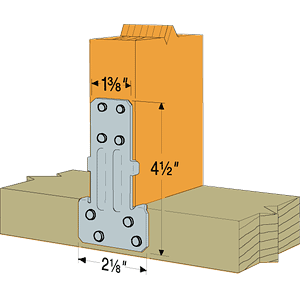Anybody ever heard that code dictates toe nailing of studs to top and bottom plates instead of shooting nails through the top or bottom face of the plates into the studs?

Toe nail and face nailing
Mike Finley
21 - 34 of 34 Posts
shooting nails through the top or bottom face of the plates into the studs?
That is refered to as "end nailing"
Never built that way in Ohio. Not sure why an engineer would spec that. I guess the walls get sheathed later? Here we face nail and sheath prior to standing.we prevent uplift by extending the scathing down past the bottom plate and over the rim.
Doesn't everyone? I don't think I've done a house down here in 25 years without them.Wait until you have to use these little jewels:
![Image]()
Or these:
![Image]()
Willie, two for the bottom and two for the top plate? With the added expense, it really makes me wonder if they are necessary.
When many Simpson column and girder fasteners cost over a hundred bucks apiece, it DOES get ridiculous.
Joined
·
1,596 Posts
No, never seen them before. We don't use any hardware on walls.Doesn't everyone? I don't think I've done a house down here in 25 years without them.
Joined
·
5,035 Posts
ive never heard of toenailing specifically required.
in situations its all that can be done and code does state what size of nail to use and how many instead of face nailing
in situations its all that can be done and code does state what size of nail to use and how many instead of face nailing
Joined
·
3,432 Posts
The code is just the least you can do and and legally comply, but may not be the right way for the specific job.
Joined
·
5,035 Posts
i understand that, very much so, but i dont get why toenailing is required over face nailing. face nailing provides a stonger connection.
for our basement walls we set both plates down on the slab,and run our chalk lines. from there we mark as anyone else would, but we keep the sole plate unnattached, from there we simply face frame the entire wall then stand it,
we toenail our trusses then use hurricane straps. i just dont get toenailing being hte required method. proof that fasteners are there i guess for the inspectors. how hard is it to simpy hit hte bottom of the studs to make sure they dont move?
for our basement walls we set both plates down on the slab,and run our chalk lines. from there we mark as anyone else would, but we keep the sole plate unnattached, from there we simply face frame the entire wall then stand it,
we toenail our trusses then use hurricane straps. i just dont get toenailing being hte required method. proof that fasteners are there i guess for the inspectors. how hard is it to simpy hit hte bottom of the studs to make sure they dont move?
Joined
·
14,248 Posts
If I had to toe nail to prove sufficient nailing, I'd still box nail the walls, stand them up, then install toe nails for decoration.:thumbsup:
Joined
·
5,035 Posts
would the nails be multi colored like xmas lights?
Joined
·
14,248 Posts
I like the gold colored electro galvies, but Christmas is coming, so I'll throw in some silver and gold.:whistlingwould the nails be multi colored like xmas lights?
I've never been required to toenail, but I don't see why it wouldn't provide a stronger connection (assuming no split wood etc.). With the "X" connection provided by toenailing, you're combining sheer resistance with ...uh, "pullout" resistance. The combo of the two is certainly stronger than pullout alone.i understand that, very much so, but i dont get why toenailing is required over face nailing. face nailing provides a stonger connection.
At least it has been any time I screwed up and had to tear things apart to re-do them.
Not sure I agree. Although when we do toenail we use more nails. That in itself will increase the shear resistance. Toenails must be on the proper angle to be effective too. When face nailing its hard to screw up the proper angle.:thumbsup:I've never been required to toenail, but I don't see why it wouldn't provide a stronger connection (assuming no split wood etc.). With the "X" connection provided by toenailing, you're combining sheer resistance with ...uh, "pullout" resistance. The combo of the two is certainly stronger than pullout alone.
At least it has been any time I screwed up and had to tear things apart to re-do them.
21 - 34 of 34 Posts
-
?
-
?
-
?
-
?
-
?
-
?
-
?
-
?
-
?
-
?
-
?
-
?
-
?
-
?
-
?
-
?
-
?
-
?
-
?
-
?
- posts
- 3.6M
- members
- 169K
- Since
- 2003
A forum community dedicated to professional construction and remodeling contractors. Come join the discussion about the industry, trades, safety, projects, finishing, tools, machinery, styles, scales, reviews, accessories, classifieds, and more!
Explore Our Forums





